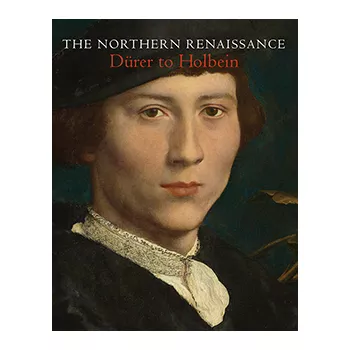Virgin and Child with Saints 1480s
Oil on panel | 42.0 x 24.5 cm (whole object) | RCIN 407817
-
Thought to be a variation based on a lost original by Hugo Van der Goes, this painting shows the Virgin and Child seated on a low wall in a garden. Five female saints – Catherine, Ursula, Agnes, Margaret and Barbara variously kneel or sit at the foot of the Virgin and Child in the verdant landscape. A richly decorated canopy floats above them, supported by small angels. The painting incorporates the scene of the Mystic Marriage of St Catherine. The Christ Child is shown looking directly at St Catherine (identifiable by the fragment of a wheel and her sword of execution) as he hands her a wedding ring, symbolising the saint’s spiritual union with God. St Barbara – with towers decorating her necklace alluding to her imprisonment, and holding a red circlet from which the Christ Child may have just taken the ring – appears to be acting as a witness to the ceremony. St Margaret holds her attribute of a gold cross, and St Agnes holds a ring to signify she too was espoused to Christ. The figure of Ursula, with her emblem of an arrow beside her, is reminiscent of drawing after Van der Goes of c.1475 (Courtauld Institute of Art, London) but the robes in the Courtauld drawing are fuller, indicating a more sophisticated hand.
The theme of the Virgin and Child surrounded by Virgin martyrs was common, and numerous versions of this composition survive and are generally attributed to followers of Van der Goes or to the Master of the St Lucy Legend (for example The Virgin among Virgins in a Rose Garden, c.1480, Detroit Institute of Arts). A more elaborate variation is found in the left wing of Memling’s Diptych of Jan du Cellier, c.1489 (Musée du Louvre, Paris). The reverse of the panel was originally painted, which indicates that this was not intended to be a stand-alone image and might have formed the left-hand wing of a diptych. The small-scale and contemplative mood of the painting would make it ideally suited as a devotional painting, to aid private meditation.
Hugo Van der Goes is best known for the Portinari Triptych, c. 1476 (Galleria degli Uffizi, Florence) and other attributions to the artist are based on comparisons with this masterpiece. As one of the most significant fifteenth-century painters from the Northern Netherlands, surprisingly little is known about the artist. He entered the painters’ guild in Ghent in 1467 but Karel Van Mander in his Dutch and Flemish Painters of 1604 mistakenly placed him in Bruges, despite referencing works by him in Ghent. In the mid-1470s Van der Goes entered an Augustinian Monastery and an account written by Gaspar Ofhuys, who knew him there, indicates that he was anxious about the vast amount of artistic ideas that he did not have time to complete.
Text adapted from Northern Renaissance: Durer to Holbein, London 2011Provenance
Purchased on behalf of the Prince Consort (1819-1861) by Ludwig Gruner (1801-1882) from Ludwig Metzger in Florence, 1845; recorded in the Page's Waiting Room at Osborne in 1876
-
Creator(s)
Acquirer(s)
-
Medium and techniques
Oil on panel
Measurements
42.0 x 24.5 cm (whole object)










